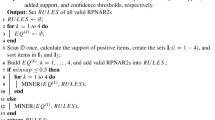Abstract
An association classification algorithm has been developed to explore adverse drug reactions in a large medical transaction dataset with unbalanced classes. Rules discovered can be used to alert medical practitioners when prescribing drugs, to certain categories of patients, to potential adverse effects. We assess the rules using survival charts and propose two kinds of probability trees to present them. Both of them represent the risk of given adverse drug reaction for certain categories of patients in terms of risk ratios, which are familiar to medical practitioners. The first approach shows risk ratios when all rule conditions apply. The second presents the risk associated with a single risk factor with other parts of the rule identifying the cohort of the patient subpopulation. Thus, the probability trees can present clearly the risk of specific adverse drug reactions to prescribers.
The authors acknowledge the Commonwealth Department of Health and Ageing, and the Queensland Department of Health for providing data and support for this research.
Preview
Unable to display preview. Download preview PDF.
Similar content being viewed by others
References
Fram, D.M., Almenoff, J.S., DuMouchel, W.: Empirical bayesian data mining for discovering patterns in post-marketing drug safety. In: Proceedings of KDD 2003, pp. 359–368 (2003)
Murff, H.J., Patel, V.L., Hripcsak, G., Bates, D.W.: Detecting adverse events for patient safety research: a review of current methodologies. Journal of Biomedical Informatics 36(1/2), 131–143 (2003)
Reid, M., Euerle, B., Bollinger, M.: Angioedema (2002), http://www.emedicine.com/med/topic135.htm
Li, J., Shen, H., Topor, R.: Mining the optimal class association rule set. Knowledge-Based Systems 15(7), 399–405 (2002)
Newman, S.C.: Biostatistical Methods in Epidemiology. John Wiley & Sons, Chichester (July 2001)
Williams, G., He, H., Chen, J., Jin, H., McAullay, D., Sparks, R., Cui, J., Hawkins, S., Kelman, C.: QLDS: Adverse drug reaction detection towards automation. Technical Report CMIS 04/91, CSIRO Mathematical and Information Sciences, Canberra (2004)
Author information
Authors and Affiliations
Editor information
Editors and Affiliations
Rights and permissions
Copyright information
© 2005 Springer-Verlag Berlin Heidelberg
About this paper
Cite this paper
Chen, J. et al. (2005). Representing Association Classification Rules Mined from Health Data. In: Khosla, R., Howlett, R.J., Jain, L.C. (eds) Knowledge-Based Intelligent Information and Engineering Systems. KES 2005. Lecture Notes in Computer Science(), vol 3683. Springer, Berlin, Heidelberg. https://doi.org/10.1007/11553939_170
Download citation
DOI: https://doi.org/10.1007/11553939_170
Publisher Name: Springer, Berlin, Heidelberg
Print ISBN: 978-3-540-28896-1
Online ISBN: 978-3-540-31990-0
eBook Packages: Computer ScienceComputer Science (R0)




